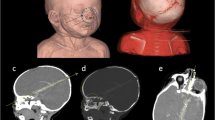Abstract
Background
Postmortem radiography may reveal skeletal and soft-tissue abnormalities of importance for the diagnosis of cause of death.
Objective
To review the radiographs of children under 3 years of age who had died suddenly and unexpectedly. To compare the radiological and autopsy findings evaluating possible differences in children dying of SIDS and of an explainable cause.
Materials and methods
A total of 110 consecutive skeletal surveys performed between 1998 and 2002 were reviewed. All but one were performed before autopsy and comprised AP views of the appendicular and axial skeleton and thorax/abdomen, lateral views of the axial skeleton and thorax, and two oblique views of the ribs. Radiography and autopsy findings were compared.
Results
Causes of death were classified as SIDS/borderline SIDS (n = 52) and non-SIDS (n = 58), with one case of abuse. In 102 infants there were 150 pathological findings, 88 involving the chest, 24 skeletal, and 38 miscellaneous findings. The radiological–pathological agreement was poor concerning pulmonary findings. Skeletal findings were sometimes important for the final diagnosis.
Conclusions
Radiography revealed many skeletal and soft-tissue findings. Pulmonary pathology was most frequently found, but showed poor agreement with autopsy findings. Recognizing skeletal findings related to abuse is important, as these may escape recognition at autopsy.





Similar content being viewed by others
References
American Academy of Pediatrics (2001) Committee on Child Abuse and Neglect; distinguishing sudden infant death syndrome from child abuse fatalities. Pediatrics 107:437–441
American Academy of Pediatrics (2006) Committee on Child Abuse and Neglect; distinguishing sudden infant death syndrome from child abuse fatalities. Pediatrics 118:421–427
Williamson SL, Perrot LL (1990) The significance of postmortem radiographs in infants. J Forensic Sci 35:365–367
McGraw P, Pless JE, Pennington DJ et al (2002) Postmortem radiography after unexpected death in neonates, infants, and children: should imaging be routine? AJR 178:1517–1521
Kleinman PK (1998) Diagnostic imaging of child abuse, 2nd edn. Mosby, St. Louis, pp 8–167, 242–246
Thomsen TK, Elle B, Thomsen JL (1997) Post-mortem radiological examination in infants: evidence of child abuse? Forensic Sci Int 90:223–230
Lonergan GJ, Baker AM, Morey MK et al (2003) From the archives of AFIP. Child abuse: radiologic-pathologic correlation. Radiographics 23:811–845
Arnestad M, Vege A, Rognum TO (2002) Evaluation of diagnostic tools applied in the examination of sudden unexpected deaths in infancy and early childhood. Forensic Sci Int 125:262–268
Gregersen M, Rajs J, Laursen H et al (1995) Pathologic criteria for the Nordic study of SIDS. In: Rognum TO (ed) Sudden infant death syndrome – new trends in the nineties. Scandinavian University Press, Oslo, pp 50–58
American Academy of Pediatrics (2004) Sudden infant death syndrome and unclassified sudden infant deaths: a definitional and diagnostic approach. Pediatrics 114:234–238
Rognum TO, Arnestad M, Bajanowski T et al (2003) Consensus on diagnostic criteria for the exclusion of SIDS. Scand J Forensic Sci 9:62–73
Bulloch B, Schubert CJ, Brophy PD et al (2000) Cause and clinical characteristics of rib fractures in infants. Pediatrics 105:e48
Kleinman PK, Marks SC, Richmond JR et al (1995) Inflicted skeletal injury: a postmortem radiologic-histopathologic study in 31 infants. AJR 165:647–650
Quisling RG, Poznanski AK, Roloff DW et al (1974) Postmortem gas accumulation in premature infants. Radiology 113:155–159
Foote GA, Wilson JA, Stewart MB (1978) Perinatal post-mortem radiography – experience with 2500 cases. Br J Radiol 51:351–356
Cole AJ, Griffiths D, Lavender S et al (2006) Relevance of postmortem radiology to the diagnosis of fatal cerebral gas embolism from compressed air diving. J Clin Pathol 59:489–491
Spevak MR, Kleinman PK, Belanger PL et al (1994) Cardiopulmonary resuscitation and rib fractures in infants. A postmortem radiologic-pathologic study. JAMA 272:617–618
Price EA, Rush LR, Perper JA et al (2000) Cardiopulmonary resuscitation-related injuries and homicidal blunt abdominal trauma in children. Am J Forensic Med Pathol 21:307–310
Author information
Authors and Affiliations
Corresponding author
Rights and permissions
About this article
Cite this article
de Lange, C., Vege, Å. & Stake, G. Radiography after unexpected death in infants and children compared to autopsy. Pediatr Radiol 37, 159–165 (2007). https://doi.org/10.1007/s00247-006-0364-2
Received:
Revised:
Accepted:
Published:
Issue Date:
DOI: https://doi.org/10.1007/s00247-006-0364-2




